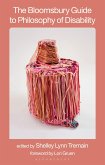The Bloomsbury Guide to Philosophy of Disability is a revolutionary collection encompassing the most innovative and insurgent work in philosophy of disability. Edited and anthologized by disabled philosopher Shelley Lynn Tremain, this book challenges how disability has historically been represented and understood in philosophy: it critically undermines the detrimental assumptions that various subfields of philosophy produce; resists the institutionalized ableism of academia to which these assumptions contribute; and boldly articulates new anti-ableist, anti-sexist, anti-racist, queer, anti-capitalist, anti-carceral, and decolonial insights and perspectives that counter these assumptions. This rebellious and groundbreaking book's chapters-most of which have been written by disabled philosophers-are wide-ranging in scope and invite a broad readership. The chapters underscore the eugenic impetus at the heart of bioethics, talk back to the whiteness of work on philosophy and disability with which philosophy of disability is often conflated, and elaborate phenomenological, poststructuralist, and materialist approaches to a variety of phenomena. Topics addressed in the book include: disability, race, and algorithms; race, disability, and reproductive technologies; disability and music; disabled and trans identities and emotions; the apparatus of addiction; and disability, race, and risk. With cutting-edge analyses and engaging prose, the authors of this guide contest the assumptions of Western disability studies through the lens of African philosophy of disability and the developing framework of crip Filipino philosophy; articulate the political and conceptual limits of common constructions of inclusion and accessibility; and foreground the practices of epistemic injustice that neurominoritized people routinely confront in philosophy and society more broadly. A crucial guide to oppositional thinking from an international, intersectional, and inclusive collection of philosophers, this book will advance the emerging field of philosophy of disability and serve as an antidote to the historical exclusion of disabled philosophers from the discipline and profession of philosophy. The Bloomsbury Guide to Philosophy of Disability is essential reading for faculty and students in philosophy, disability studies, political theory, Africana studies, Latinx studies, women's and gender studies, LGBTQ studies, and cultural studies, as well as activists, cultural workers, policymakers, and everyone else concerned with matters of social justice. Description of the book's cover: The book's title appears on two lines across the top of the cover which is a salmon tone. The names of the editor and the author of the foreword appear in white letters at the bottom of the book. The publisher's name is printed along the right side in white letters. At the centre, a vertical white rectangle is the background for a sculpture by fibre artist Judith Scott. The sculpture combines layers of shiny yarn in various colours including orange, pink, brown, and rust woven vertically on a large cylinder and horizontally around a smaller cylinder, as well as blue yarn woven around a protruding piece at the bottom of the sculpture. The sculpture seems to represent a body and head of a being sitting down, a being with one appendage, a fat person, or a little person.
Hinweis: Dieser Artikel kann nur an eine deutsche Lieferadresse ausgeliefert werden.
Hinweis: Dieser Artikel kann nur an eine deutsche Lieferadresse ausgeliefert werden.








